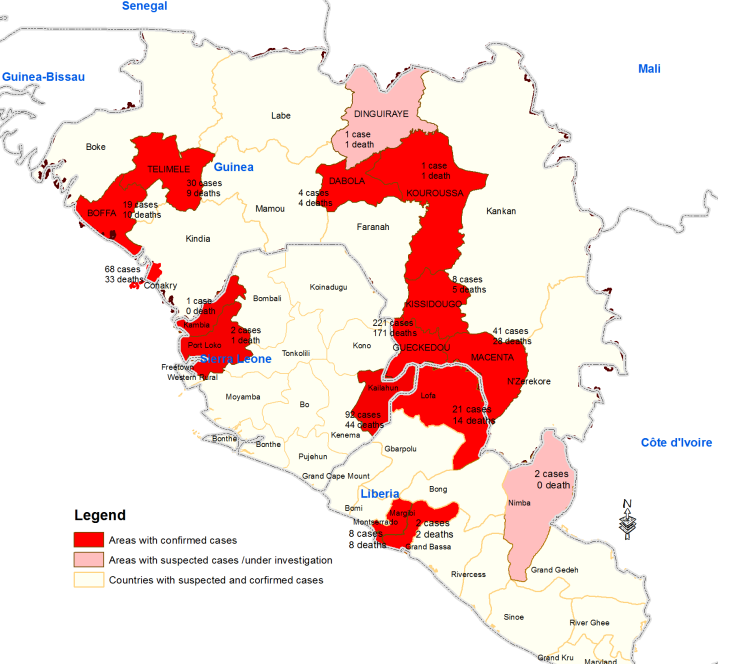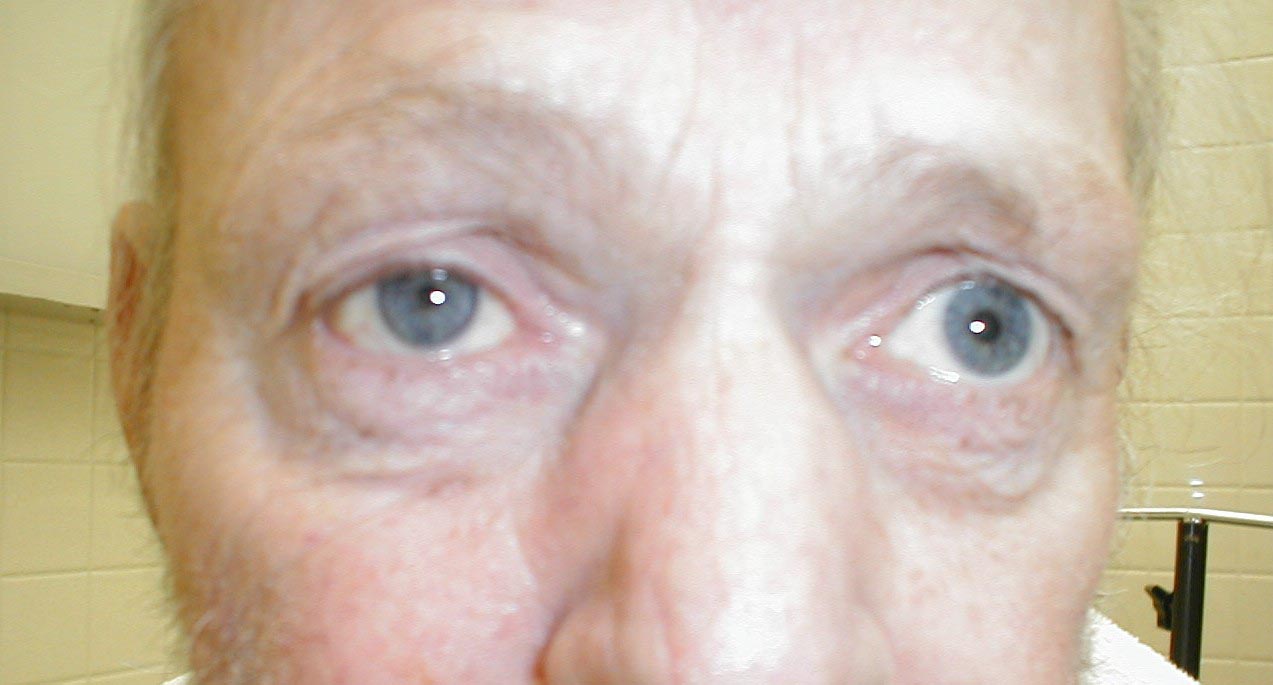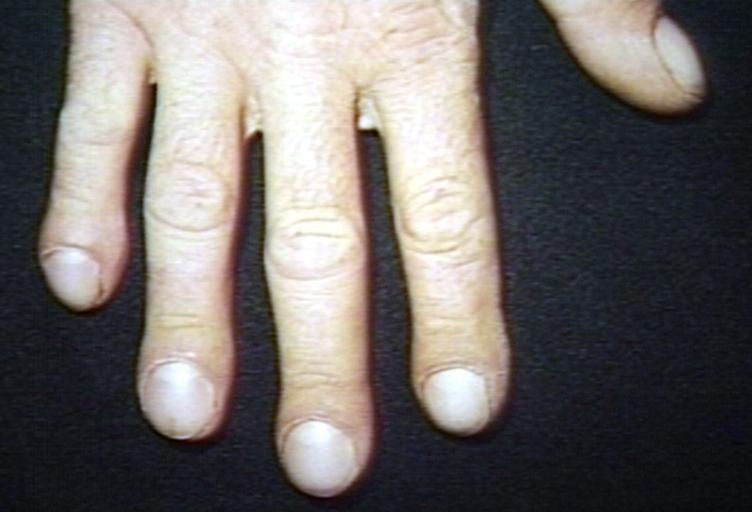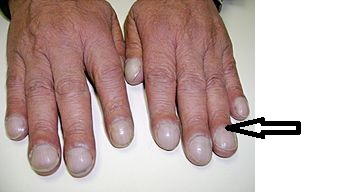Sandbox/ebola
West Africa outbreak


On March 23, 2014, the Ministry of Health of Guinea notified the World Health Organization WHO) of a rapidly evolving outbreak of Ebola virus disease (EVD) in forested areas south eastern Guinea: Guekedou, Macenta, Nzerekore and Kissidougou districts. As of 22 March, 2014, a total of 49 cases including 29 deaths (case fatality ratio: 59%) were reported. Four health care workers were among the victims. At the same time, suspected cases in border areas of Liberia and Sierra Leone were being investigated. Six blood samples were tested at Institut Pasteur in Lyon, France, resulting positive for Ebola virus by PCR, confirming the first Ebola virus disease outbreak in Guinea. Preliminary results from sequencing of a part of the L gene showed strong homology with Zaire Ebolavirus. The ministry of health together with the WHO and other partners initiated measures to control the outbreak and prevent further spread. Médecins Sans Frontières, Switzerland (MSF-CH) started working in the affected areas and assisted with the establishment of isolation facilities, and also supported transport of the biological smaples from suspected cases and contacts to international reference laboratories for urgent testing. The Emerging and Dangerous Pathogens Laboratory Network (EDPLN) worked with the Guinean VHF Laboratory in Donka, the Institut Pasteur in Lyon, the Institut Pasteur in Dakar, and the Kenema Lassa fever laboratory in Sierra Leone to make available appropriate Filovirus diagnostic capacity in Guinea and Sierra Leone.[1]
On 30 March, 2014, the Ministry of Health of Liberia provided updated details on the suspected and confirmed cases of Ebola virus disease in Liberia. As of 29 March, seven clinical samples, all from adult patients from Foya district, Lofa County, were tested by PCR using Ebola Zaire virus primers by the mobile laboratory of the Institut Pasteur (IP) Dakar in Conakry. Two of those samples tested positive for the ebolavirus. There were 2 deaths among the suspected cases; a 35 year-old woman who died on 21 March tested positive for ebolavirus while a male patient who died on 27 March tested negative. At that time, Foya was the only district in Liberia that reported confirmed or suspected cases of Ebola Hemorrhagic Fever. As of 26 March, Liberia had 27 contacts under medical follow-up. Liberia established a high level National Task Force to lead the response. Response partners include WHO, the International Red Cross (IRC), Samaritan’s Purse (SP) Liberia, Pentecostal Mission Unlimited (PMU)-Liberia, CHF-WASH Liberia, PLAN-Liberia, UNFPA and UNICEF.[3]
On 3 April, 2014, the outbreak was confirmed to be caused by a strain of ebolavirus with very close homology (98%) to the Zaire ebolavirus. This is the first time the disease has been detected in West Africa.[4]
As of 17 June 2014, in Guinea a total of 7 new cases and 5 new deaths were reported from Gueckedou (4 cases and 5 deaths) and Boffa (3 cases and 0 deaths). This brings the cumulative number of cases and deaths reported from Guinea to 398 (254 confirmed, 88 probable and 56 suspected) and 264 deaths. The geographical distribution of these cases and deaths is as follows: Conakry (70 cases and 33 deaths); Guéckédou (224 cases and 173 deaths); Macenta (41 cases and 28 deaths); Dabola, (4 cases and 4 deaths); Kissidougou (8 cases and 5 deaths); Dinguiraye (1 case and 1 death); Telimele (30 cases and 9 deaths); Bofa (19 cases and 10 deaths) and Kouroussa (1 case and 1 death). Twenty four (24) patients are currently in EVD Treatment Centres: Conakry (6), Guéckédou (9), Telimele (3) and Boffa (6). The number of contacts currently being followed countrywide is 1,258 and distributed as follows: Conakry (252), Guéckédou (529), Macenta (52), Telimele (118), Dubreka (118) and Boffa (189). So far 69.4% (2,848 contacts being followed-up out of a 4,106 contacts registered since the beginning of the outbreak) have completed the mandatory 21 days observation period.
In Liberia a total of 9 new cases and 5 new deaths were reported from Lofa (6 cases and 0 death) and Montserado (3 cases and 5 deaths). This brings the cumulative number of cases and deaths reported from Liberia to 33 (18 confirmed, 8 probable and 7 suspected) and 24 deaths. The geographical distribution of these cases and deaths is as follows: Lofa (21 cases and 14 deaths); Montserado (8 cases and 8 deaths); Margibi (2 cases and 2 deaths) and Nimba (2 cases and 0 death). Five (5) patients are currently in EVD Treatment Centres in Lofa. The number of contacts currently being followed countrywide is 108 and distributed as follows: Lofa (95), Montserado (13). So far 41.5% (108 contacts being followed-up out of a 260 contacts registered since the beginning of the outbreak) have completed the mandatory 21 days observation period.
In Sierra Leone a total of 31 new cases and 4 new deaths were reported from Kailahun (29 cases and 4 deaths), Kono (1 case) and Western (1 case). This brings the cumulative number of cases and deaths reported from Sierra Leone to 97 (92 confirmed, 3 probable and 2 suspected) and 49 deaths. The geographical distribution of these cases and deaths is as follows: Kailahun (92 cases and 46 deaths); Kambia (1 cases and 0 deaths); Port Loko (2 cases and 1 deaths); Kono, (1 case and 0 death) and Western (1 cases and 1 death. Thirty three (33) patients are currently in EVD Treatment Centre of Kenema. The number of contacts currently being followed countrywide is 37 from Kailahun. Contact listing is continuing in Kailahun, Kambia and Port Loko.[5]
References
- ↑ 1.0 1.1 "Ebola Hemorrhagic Fever in Guinea".
- ↑ "Ebola Virus Disease (EVD) in West Africa (situation as of 16 June 2014)".
- ↑ "30 March 2014 Ebola virus disease in Liberia".
- ↑ "3 April 2014 Ebola virus disease: background and summary".
- ↑ "Ebola virus disease, West Africa (Situation as of 17 June 2014)".
physical
Vital signs
- Fever: up to 20% of patients with lung cancer
General appearance
- Cachexic: weight loss and anorexia
- Jaundice: liver metastases
- Pale skin and conjunctiva: anemia of chronic disease.
- Cyanotic: dyspnea
- Lymphadenopathy (> 1 cm)
- Soft tissue mass
HEENT
Head
- Moon facies: Cushing's syndrome
Eyes
- Jaundice: liver metastases OR
- Conjunctival pallor: anemia of chronic disease
- Miosis, ipsilateral ptosis and lack of facial sweating: Horner's syndrome
Throat
Lungs
- Unilateral wheeze
- Pleural effusion
Abdomen
- Hepatomegaly (> 13 cm span): liver metastases
Musculoskeletal system
- Digital clubbing
- Bone tenderness: bone metastases
- Osteoarthropathy: painful symmetrical arthropathy of the knees, wrist, and knees, and periosteal new bone formation.
Neurological
- Ataxia, dysarthria, nystagmus and sever vertigo: cerebellar degeneration
- Proximal muscles of lower extremities weakness and fatiguability, abnormal gait, hyporeflexia, increased deep-tendon reflexes after facilitation, autonomic dysfunction, and paresthesias



